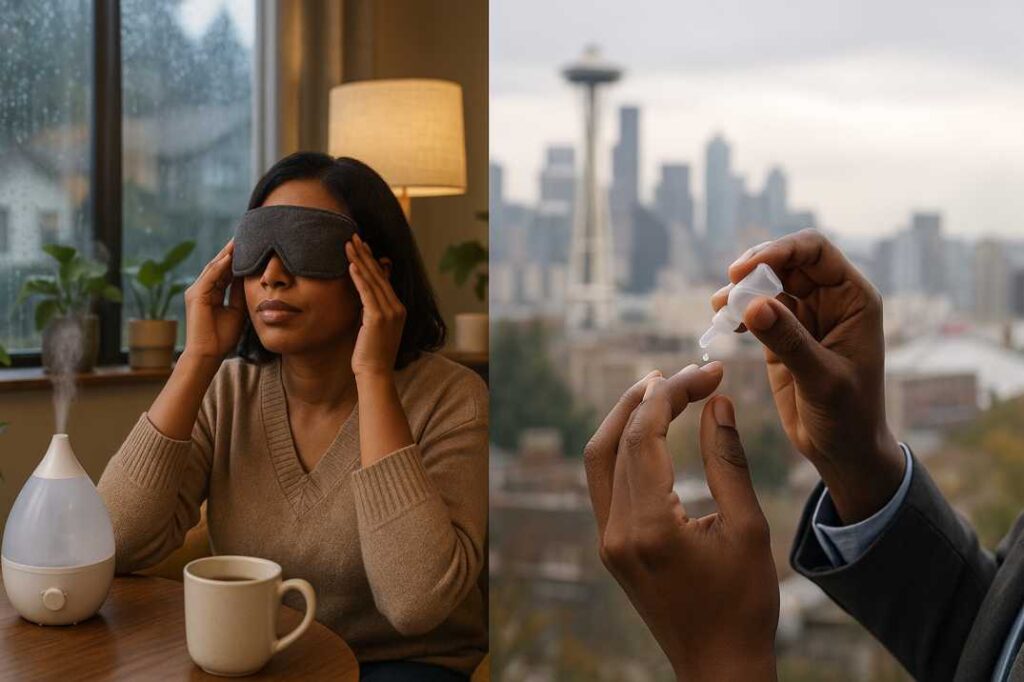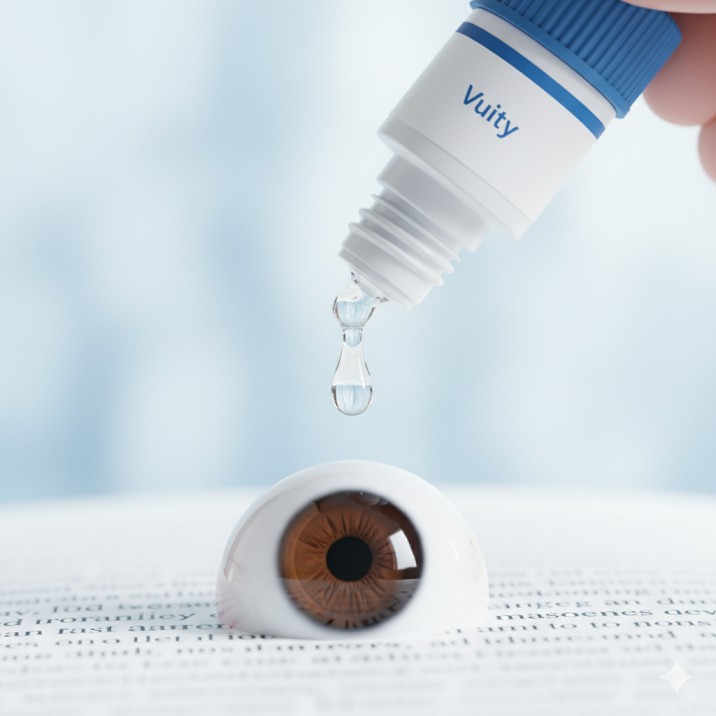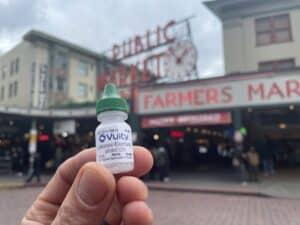Dry Eye Relief Tips for Seattle’s Climate
Executive Summary
Despite Seattle’s reputation for rainy weather, the city’s unique climate patterns create significant challenges for dry eye sufferers. Seattle averages 70-73% humidity annually, yet indoor heating during wet seasons and seasonal humidity fluctuations between 60-85% make targeted dry eye relief essential year-round. This comprehensive guide provides evidence-based strategies specifically adapted to Seattle’s Pacific Northwest climate, helping residents achieve lasting comfort through environmental modifications, professional treatments, and lifestyle adaptations.
Understanding Dry Eye Relief in Seattle’s Climate
Seattle’s climate presents unique challenges for those seeking effective dry eye relief. While the city receives substantial rainfall, particularly during winter months, averaging 4.84 inches in December, several climate-specific factors contribute to widespread dry eye issues among the region’s 750,000+ residents.
The Seattle Climate Challenge for Dry Eye Relief
In Seattle’s climate, dew points rarely exceed 65°F, creating a perception of dryness despite actual humidity levels. This meteorological phenomenon means that effective dry eye relief requires understanding both outdoor environmental factors and indoor climate control systems that significantly impact ocular surface health.
Climate-Specific Eye Health Factors:
Seattle’s seasonal variations create distinct challenges for maintaining ocular comfort throughout the year. The dry season occurs primarily from June through August, with precipitation dropping to just 0.12 inches in August, while winter humidity surges to 81-85%. These dramatic fluctuations require adaptive dry eye relief strategies.
Indoor heating systems during Seattle’s wet seasons create warm, dry environments that accelerate tear evaporation rates. Research demonstrates that seasonal temperature changes impact dry eye symptoms more significantly than absolute temperature readings, making Seattle’s 40-degree temperature swings particularly challenging for consistent symptom management.
Temperature variations between Seattle’s 35-50°F winters and 65-79°F summers, combined with indoor heating and cooling systems, create a complex environment requiring year-round attention to ocular surface health.
Why Seattle’s Climate Challenges Dry Eye Relief
Environmental Triggers Specific to Seattle’s Climate
Achieving effective dry eye relief in Seattle’s climate requires understanding these specific environmental challenges that differentiate the Pacific Northwest from other regions.
Indoor Heating System Impact
During Seattle’s cooler months from October through March, warming indoor spaces decreases relative humidity to levels as low as 20-30%, significantly below the optimal 40-50% range for ocular comfort. This creates challenging conditions where residents escape outdoor moisture only to encounter environments that actively deplete tear film stability.
Seasonal Air Quality Variations
Seattle’s air quality fluctuates seasonally, with summer wildfire smoke and urban pollution compounding dry eye symptoms. Poor indoor air quality from heating systems, dust accumulation, and limited ventilation during wet months directly impacts tear film composition and stability.
Temperature Fluctuation Effects
Research confirms that changes in temperature between seasons influence dry eye symptoms more than absolute seasonal temperatures. Seattle’s dramatic seasonal shifts from maritime influence to continental patterns create ongoing challenges for maintaining consistent tear film function.
The Science Behind Climate-Related Dry Eye
Recent clinical studies demonstrate that exposure to environments with humidity below 45% for just one hour can result in tear film characteristics resembling those of diagnosed dry eye patients. This finding carries particular relevance for Seattle residents experiencing significant indoor-outdoor humidity differentials throughout the day.
Tear Film Response to Seattle’s Environmental Conditions:
Heat from indoor heating systems increases evaporation rates, removing moisture from ocular surfaces more rapidly than normal physiological replacement can occur. Cold weather conditions have been clinically shown to lower tear break-up time while simultaneously decreasing tear stability and lipid layer thickness, creating compounding challenges for effective dry eye relief.
Environmental pollutants and seasonal allergens present in Seattle’s urban atmosphere can trigger inflammatory responses on the ocular surface, further complicating the environmental challenges inherent in the region’s climate patterns.
Recognizing Dry Eye Symptoms in Seattle’s Climate
Symptoms Requiring Professional Attention
Based on observations from Pacific Northwest eye care providers, Seattle’s climate frequently triggers specific symptomatology requiring targeted intervention strategies.
Primary Symptoms Requiring Immediate Attention:
Gritty sensations resembling sand or foreign body presence, particularly pronounced upon awakening or following extended digital device use, commonly occur during Seattle’s dry summer months when humidity drops to 60-65%. These symptoms often intensify during the evening hours when atmospheric humidity reaches daily minimums.
Paradoxical excessive tearing while reading, driving, or during Seattle’s characteristic windy conditions frequently signals underlying dry eye requiring professional evaluation. This compensatory tearing represents inadequate tear film quality rather than sufficient lubrication.
Visual blur that temporarily improves following conscious blinking efforts, especially during prolonged computer work common in Seattle’s technology sector, indicates tear film instability requiring systematic intervention.
Environmental Symptom Triggers in Seattle:
Symptom severity correlates directly with windy conditions and winter months when indoor heating systems operate continuously. The combination of external wind exposure and internal heating creates optimal conditions for accelerated tear evaporation.
Ocular redness or burning sensations that develop throughout the day, particularly when combined with digital screen exposure and seasonal allergen exposure, represent common presentations requiring climate-adapted treatment approaches.
Seasonal Pattern Recognition
Winter Symptom Intensification:
Seattle’s winter months, from November through February, present the greatest challenges for dry eye management. Average temperatures of 35-50°F combined with indoor heating systems, creating sub-optimal humidity levels, dramatically reduce tear film stability. Cold winds and precipitation increase ocular surface exposure to harsh environmental conditions.
Summer Climate Complications:
During Seattle’s dry season, atmospheric humidity drops to annual minimums while air conditioning systems in vehicles and buildings create forced air environments that accelerate tear evaporation. Smoke exposure from outdoor cooking and regional wildfire activity compounds these environmental challenges.
Dust and particulate matter from increased outdoor activities during Seattle’s limited dry months can irritate ocular surfaces, creating additional barriers to effective dry eye relief during periods when environmental humidity should theoretically provide natural symptom amelioration.
Evidence-Based Dry Eye Relief Strategies for Seattle’s Climate
Immediate Environmental Modifications
Indoor Climate Optimization for Dry Eye Relief
Humidification systems providing 40-50% relative humidity during Seattle’s heating season (October through March) can provide significant symptom improvement. Strategic placement of humidifiers in primary living and work spaces helps counteract the drying effects of forced-air heating systems common in Pacific Northwest construction.
Environmental Control Strategies:
Positioning workstations and seating areas away from direct heating vents and air conditioning units becomes particularly important during Seattle’s climate extremes. Air quality improvement through regular HVAC maintenance, air filtration, and strategic ventilation during milder months can significantly impact ocular comfort.
Growing indoor plants that naturally increase atmospheric moisture, such as Boston ferns and peace lilies, provides supplemental humidity while improving overall indoor air quality during Seattle’s extended indoor seasons.
Advanced Thermal Therapy Protocols
Clinical research confirms that meibomian secretions undergo phase transitions at temperatures ranging from 30-32°C for healthy patients and 32-36°C for those with meibomian gland dysfunction. Therapeutic heat application requires 10 minutes to penetrate tarsal plates and achieve 40°C temperatures at the inner eyelid surfaces necessary for therapeutic effect.
Effective Thermal Treatment Implementation:
Daily warm compress therapy using specialized heating devices, maintaining consistent temperatures, provides superior results compared to traditional warm washcloth methods. Treatment protocols involving 10-15 minute applications twice daily during Seattle’s challenging climate periods can restore normal gland function.
Professional-grade heating systems like the BRUDER Moist Heat Eye Compress maintain therapeutic temperatures throughout treatment duration, ensuring adequate heat penetration for meibomian gland expression and improved lipid layer function.
Professional Treatment Options for Seattle Climate Challenges
Advanced In-Office Dry Eye Relief Treatments
Seattle eye care providers offer sophisticated treatments specifically effective for addressing climate-related dry eye challenges common in the Pacific Northwest region.
Intense Pulsed Light therapy has demonstrated clinical efficacy in improving meibomian gland dysfunction, chalazion resolution, and overall dry eye symptom reduction. This treatment modality provides particular benefit for Seattle residents experiencing chronic inflammation exacerbated by environmental factors.
Radio Frequency treatment protocols stimulate natural meibomian gland rejuvenation, proving especially effective during Seattle’s climate extremes when indoor heating affects normal gland function. These treatments address underlying glandular dysfunction rather than providing temporary symptom masking.
Prescription Medication Options
Recent pharmaceutical advances include treatments specifically targeting inflammatory pathways involved in dry eye disease. Cyclosporine formulations have demonstrated efficacy in managing severe dry eye conditions, particularly cases unresponsive to traditional therapies common in challenging climates like Seattle’s.
Lifitegrast therapy provides rapid symptom relief, with clinical studies documenting improvement within two weeks of treatment initiation. This rapid onset proves particularly valuable for Seattle residents requiring quick adaptation to seasonal climate changes.
Device-Based Treatment Technologies
NuLids Pro treatment costs approximately $35 per professional procedure, making advanced eyelid hygiene accessible for patients experiencing climate-related dry eye challenges. Home NuLids devices, available for $299-329, provide daily maintenance therapy supporting professional treatment protocols.
Thermal pulsation devices have demonstrated sustained symptom improvement lasting up to three years following treatment, providing long-term relief for patients dealing with Seattle’s ongoing climate challenges.
Daily Lifestyle Modifications for Dry Eye Relief in Seattle’s Climate
Digital Device Management in Seattle’s Technology Sector
Given Seattle’s prominence as a major technology hub, screen-related dry eye requires specific intervention strategies adapted to both occupational demands and local climate conditions.
Digital Eye Strain Prevention Protocols:
Implementation of the 20-20-20 rule becomes particularly important in Seattle’s indoor-focused lifestyle during wet months. Every 20 minutes, focusing on objects 20 feet away for 20 seconds helps restore natural blink patterns disrupted by concentrated screen work.
Conscious blinking exercises become essential during prolonged digital device use, especially when combined with Seattle’s dry indoor heating environments. Regular blink patterns help redistribute tear film and prevent evaporative loss common in climate-controlled work environments.
Strategic screen positioning to minimize air conditioning exposure during Seattle’s warmer months helps preserve tear film stability during extended work periods common in the region’s technology sector.
Seasonal Adaptation Strategies for Dry Eye Relief
Winter Preparation for Seattle Climate Conditions
Protective eyewear becomes essential when venturing into Seattle’s harsh winter conditions, characterized by cold winds, precipitation, and low temperatures. Wraparound sunglasses or moisture chamber glasses provide necessary protection during climate extremes.
Temporary contact lens cessation during Seattle’s most challenging climate periods can provide significant relief. Switching to glasses for several days during particularly dry or windy conditions allows ocular surfaces to recover from environmental stress.
Summer Climate Management Strategies
During Seattle’s peak summer months, when humidity drops to 60-65%, avoiding additional dry environments becomes crucial for maintaining ocular comfort. Planning outdoor activities during higher humidity periods, such as early morning or late evening hours, helps minimize environmental stress.
Hydration protocols involving 2+ quarts of daily water intake become particularly important during Seattle’s dry season. Adequate systemic hydration supports natural tear production and helps counteract environmental moisture loss.
Strategic timing of outdoor activities to coincide with Seattle’s natural humidity patterns helps minimize exposure to peak evaporative conditions typically occurring during mid-day hours.
Nutritional Support for Ocular Health
Hydration and Dietary Considerations
Systematic hydration protocols prove particularly important during Seattle’s climate extremes. Adequate fluid intake supports natural tear production while helping counteract the dehydrating effects of indoor heating systems common during Pacific Northwest winters.
Omega-3 fatty acid supplementation supports tear film quality and may help reduce inflammatory responses associated with environmental triggers common in urban Pacific Northwest environments.
Limiting caffeine and alcohol consumption, which can contribute to systemic dehydration, becomes particularly important during Seattle’s challenging climate periods when ocular surfaces face additional environmental stressors.
Latest Research and Treatment Innovations (2024-2025)
Breakthrough Treatment Developments
Reproxalap Clinical Trial Results
Recent clinical trials demonstrate that Reproxalap provides a statistically significant reduction in ocular redness while increasing Schirmer test scores by ≥10mm compared to control treatments. This advancement shows particular promise for Seattle patients dealing with environmental irritation from regional air quality challenges.
Personalized Medicine Approaches
Current research emphasizes personalized treatment protocols incorporating genomic and proteomic profiling alongside patient-reported outcomes. This individualized approach proves particularly relevant for Seattle residents dealing with varied environmental triggers ranging from seasonal allergens to urban air quality fluctuations.
Environmental Medicine Integration
Contemporary research increasingly considers environmental and lifestyle factors, including pollution exposure, climate change effects, dietary influences, and behavioral modifications, in comprehensive dry eye management protocols. This holistic approach addresses the complex interplay between Seattle’s urban environment and ocular surface health.
Clinical Studies Supporting Seattle-Specific Approaches
Climate Impact Research (2024)
Recent studies confirm that residents of Mediterranean climates along the West Coast experience significantly less severe dry eye compared to patients in other climate zones. However, this research emphasizes the critical importance of microclimate management within homes and workplaces, particularly relevant for Seattle’s indoor-focused lifestyle.
Multifactorial Treatment Research (2024)
Clinical trials demonstrate that combining Intense Pulsed Light therapy with Low-Level Light Therapy significantly improves clinical indicators and molecular markers in patients with chronic meibomian gland dysfunction. These combination approaches prove particularly effective for addressing complex environmental triggers common in Seattle’s urban atmosphere.
Quality of Life Improvement Studies (2024)
Comprehensive research confirms that dry eye disease affects substantial proportions of urban populations, with new treatment combinations showing significant quality of life improvements for patients implementing systematic management strategies adapted to local environmental conditions.
Choosing Professional Eye Care in Seattle
Essential Provider Qualifications
Professional Credentials and Specialization
Board certification in ophthalmology or optometry with specialized training in ocular surface disease represents the minimum qualifications for comprehensive dry eye management. Experience with Seattle’s specific environmental challenges and familiarity with regional allergen patterns provide additional value in treatment planning.
Access to advanced diagnostic equipment, including meibomian gland imaging capabilities, tear film analysis systems, and inflammatory marker assessment tools, enables precise diagnosis and treatment monitoring essential for effective long-term management.
Treatment Philosophy and Approach
Providers who understand that dry eye represents a complex, progressive disease resulting from chronic damage to tear production and support systems offer superior care compared to those treating symptoms in isolation. Comprehensive, individualized treatment plans addressing both environmental triggers and underlying pathophysiology provide optimal outcomes.
Advanced technology access, including thermal expression devices, light-based therapies, and current prescription treatments, ensures patients receive evidence-based care incorporating the latest therapeutic advances.
Key Questions for Seattle Eye Care Providers
Climate-Specific Assessment Questions
How does Seattle’s specific climate impact individual dry eye presentations, and what environmental modifications do you recommend for residents? Understanding provider familiarity with regional environmental factors helps ensure appropriate treatment planning.
Which treatments have proven most effective for Seattle patients dealing with seasonal humidity variations and indoor heating challenges? Experience with local patient populations provides valuable insight into treatment efficacy.
What monitoring protocols do you use to track treatment progress over time, and how do you adjust therapies based on seasonal climate changes? Systematic follow-up ensures optimal long-term outcomes.
What emergency protocols exist for managing severe symptom exacerbations during Seattle’s challenging climate periods? Access to urgent care helps prevent complications during environmental stress periods.
Prevention Strategies for Long-Term Ocular Health
Climate-Resilient Eye Health Maintenance
Daily Prevention Protocols
Morning ocular hygiene routines incorporating warm compress therapy provide proactive gland maintenance before environmental exposure. Frequency recommendations of twice daily for two weeks, followed by once daily maintenance, help establish optimal gland function.
Strategic environmental awareness and proactive modification based on daily weather conditions help minimize exposure to challenging environmental factors common in Seattle’s variable climate patterns.
Regular professional monitoring through scheduled preventive care appointments during seasonal transitions ensures early identification of developing issues before they progress to symptomatic disease states.
Seasonal Preparation Strategies
Humidifier setting adjustments coordinated with weather pattern changes help maintain optimal indoor environments throughout Seattle’s dramatic seasonal transitions. Proactive equipment maintenance ensures reliable function during peak demand periods.
Artificial tear stockpiling before anticipated symptom onset during challenging climate periods prevents interruption of treatment protocols during severe weather events common in Pacific Northwest winters.
Preventive care appointment scheduling during seasonal transition periods allows professional assessment and treatment adjustment before environmental challenges intensify symptoms.
Environmental Awareness and Adaptation
Indoor Air Quality Management
Air purification systems capable of removing particulate matter and bioaerosols protect from indoor air pollutants common in sealed buildings during Seattle’s wet seasons. Regular HVAC system maintenance and filter replacement ensure optimal air quality throughout extended indoor periods.
Strategic plant placement to improve air quality while providing natural humidification offers dual benefits during Seattle’s heating season when indoor environments become particularly challenging for ocular comfort.
Outdoor Activity Modification
Local air quality index monitoring helps guide outdoor activity planning during periods when environmental conditions may exacerbate dry eye symptoms. Seattle’s variable air quality due to seasonal factors and urban pollution requires daily assessment.
Activity timing during optimal humidity periods, typically early morning and evening hours, helps minimize exposure to peak evaporative conditions while maintaining an active lifestyle during Seattle’s limited favorable weather periods.
Protective eyewear use during windy conditions provides necessary barrier protection against environmental factors that can rapidly worsen dry eye symptoms during Seattle’s variable weather patterns.
Emergency Relief and Urgent Care Protocols
Acute Symptom Management
Immediate Comfort Measures
Preservative-free artificial tear application every 15-30 minutes during acute symptom episodes provides temporary relief while avoiding additional chemical irritation common with preserved formulations. Cold compress application for inflammatory symptoms offers supplemental comfort during severe episodes.
Environmental modification through immediate relocation to humid environments, such as bathrooms with shower steam or areas with active humidification, can provide rapid symptom improvement during acute exacerbations.
Direct air exposure avoidance, including repositioning away from heating vents, air conditioning units, and outdoor wind sources, helps prevent additional environmental stress during symptomatic periods.
Professional Consultation Indicators
Sudden onset of severe pain or vision changes requires immediate professional evaluation to rule out serious complications. Symptoms that fail to respond to usual treatment protocols within 48 hours warrant professional assessment to prevent progression.
Signs of secondary infection, including purulent discharge, significant redness, or fever, require urgent medical attention to prevent complications. Persistent symptoms lasting more than 48 hours despite appropriate treatment indicate the need for professional intervention.
Emergency Preparedness for Seattle Climate
Essential Supply Management
Comprehensive emergency kits should include multiple types of preservative-free artificial tears to address varying symptom presentations during acute episodes. Warm compress systems provide immediate therapeutic intervention capability during symptom exacerbations.
Moisture chamber glasses offer emergency protection during unexpected environmental exposure to harsh conditions common during Seattle’s variable weather patterns. Emergency contact information for eye care providers ensures rapid access to professional consultation when needed.
Portable humidification devices enable environmental modification during travel or unexpected environmental challenges common in the Pacific Northwest climate variability.
Scientific Resources and Citations
This article incorporates peer-reviewed research and current clinical data. Key scientific resources supporting these recommendations include:
1. Climate Impact on Dry Eye Disease Research (2024)
Source: “Impact of dry eye disease treatment on patient quality of life” – Frontiers in Medicine
Link: https://www.frontiersin.org/journals/medicine/articles/10.3389/fmed.2024.1305579/full
Key Finding: Comprehensive analysis demonstrating how environmental factors, including humidity and temperature variations, directly impact tear film stability and patient outcomes, validating climate-adapted treatment approaches for optimal dry eye relief.
2. Meibomian Gland Temperature Therapy Research (2019)
Source: “The optimum temperature for the heat therapy for meibomian gland dysfunction” – PMC
Link: https://www.ncbi.nlm.nih.gov/pmc/articles/PMC6529265/
Key Finding: Scientific validation confirming meibomian secretions undergo phase transitions at 30-32°C for normal patients and 32-36°C for MGD patients, establishing temperature requirements for effective thermal therapy protocols.
3. Latest Dry Eye Treatment Innovations (2024)
Source: “Multidimensional immunotherapy for dry eye disease: current status and future directions” – Frontiers in Ophthalmology
Link: https://www.frontiersin.org/journals/ophthalmology/articles/10.3389/fopht.2024.1449283/full
Key Finding: Comprehensive review of emerging treatments, including biologics, stem cell therapy, and advanced device-based therapies, supporting discussion of cutting-edge treatment options available to Seattle residents.
Medical Disclaimer: This article provides educational information only and does not constitute medical advice. Individual symptoms and treatment requirements vary significantly. Always consult qualified eye care professionals for comprehensive evaluation, diagnosis, and personalized treatment planning appropriate for specific clinical presentations and environmental factors.
Strategic Implementation and Future Outlook
Comprehensive Management Approach
Climate-Specific Treatment Integration
Seattle’s unique humidity patterns necessitate year-round dry eye management strategies incorporating both seasonal adaptations and consistent baseline interventions. Indoor environmental control proves crucial during heating seasons, while outdoor protection becomes paramount during dry summer months.
Professional treatment combinations addressing multiple contributing factors provide superior outcomes compared to single-modality approaches. Regular monitoring and treatment adjustment based on seasonal changes ensures optimal management throughout Seattle’s dramatic climate variations.
Immediate Implementation Steps
Environmental assessment of home and work humidity levels provides baseline data for targeted interventions. Professional consultation with specialized providers familiar with Seattle’s climate challenges enables the development of individualized management plans.
Treatment customization based on Seattle-specific environmental factors, occupational demands, and lifestyle patterns ensures practical implementation and optimal adherence to therapeutic protocols.
Lifestyle integration of daily prevention strategies, including environmental modifications and proactive symptom management, provides a foundation for long-term ocular health maintenance.
Ongoing monitoring through regular follow-up care ensures treatment effectiveness and enables adjustment based on changing environmental conditions and treatment response patterns.
Future Developments in Dry Eye Care
With advancing research and technology development, Seattle residents have access to increasingly sophisticated treatment options addressing the complex interplay between environmental factors and ocular surface health. The future of dry eye management emphasizes precision medicine, technological integration, and a comprehensive understanding of multifactorial disease processes.
By understanding local climate impacts on ocular health and collaborating with knowledgeable providers who appreciate Seattle’s unique environmental challenges, patients can achieve lasting comfort and optimal eye health throughout the region’s variable seasonal conditions.
FAQs
-
How does Seattle's rainy climate affect dry eyes?
Seattle’s indoor heating during rainy months reduces humidity, worsening dry eye symptoms despite outdoor moisture levels.
-
What are the best eye drops for dry eyes in Seattle?
Preservative-free single-use drops like Systane gel or Refresh Plus work best in Seattle’s variable humidity conditions.
-
When do dry eye symptoms get worse in Seattle?
-
Winter months with indoor heating
-
Air-conditioned summer environments
-
Windy coastal days
-
During screen-heavy remote work
-
-
Why do my eyes feel worse indoors than outdoors in Seattle?
Indoor heating and air conditioning create artificial dry environments, while natural outdoor humidity provides relief.
-
Which humidifier settings help dry eyes in Seattle homes?
Maintain 40-50% indoor humidity using bedroom humidifiers, especially during heating season months.
-
How often should I use eye drops in Seattle's climate?
Apply preservative-free drops every 1-2 hours, increasing frequency during heating season or air-conditioned periods.
-
What protective eyewear helps with Seattle's wind and weather?
Wraparound sunglasses or moisture chamber glasses block wind while maintaining eye moisture in variable conditions.
-
Does drinking more water help with dry eyes in Seattle?
Yes, increased hydration supports tear production, especially important in Seattle’s dehydrating indoor environments during winter.
-
Can Seattle's air quality worsen dry eye symptoms?
Poor air quality days increase eye irritation, making protective eyewear and frequent artificial tears essential.
-
Should I use a warm compress for dry eyes in Seattle?
Apply warm compresses for 15 minutes before bed to improve oil gland function and reduce morning dryness.
-
Do contact lenses make dry eyes worse in Seattle's climate?
Contact lenses can worsen symptoms; consider daily disposables or contact-friendly lubricating drops for relief.
-
When should I see an eye doctor for dry eyes in Seattle?
Consult an ophthalmologist if symptoms persist despite humidifiers, quality eye drops, and environmental modifications.




